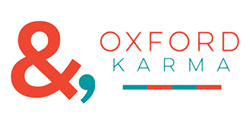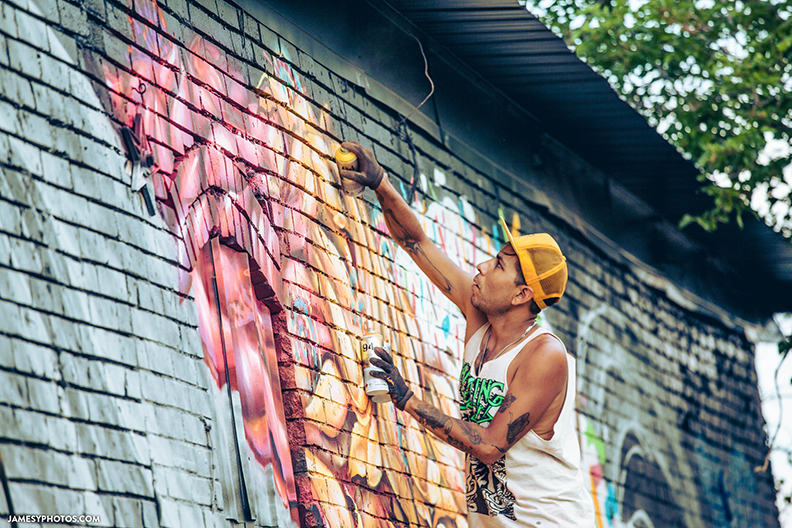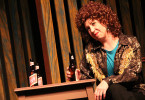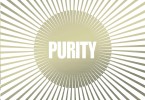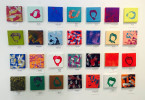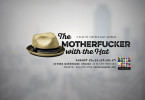9th Street Braid opening reception
6-9 p.m. Saturday, May 30
Automobile Alley | Oklahoma City
The red brick and gray concrete of Oklahoma City has been slowly but surely getting a face-lift. Once bare walls, now streaked with color, have become visual manifestations of local artists and their vision of the city they love.
Completed just a few weeks ago, Automobile Alley’s 130-foot 9th St. Braid is the latest example of a city brought to life through the artistry of its people. It’s a joint effort between three graphic masters – Dylan Bradway, Yatika Starr Fields and Kristopher Kanaly – and is representative of the area’s melting pot of cultural perspectives.
We spoke to Bradway about the planning of the mural, his specific vision and his hopes as to the impact of future public art projects.
Oxford Karma: So first off, what led you to answer this public call for artists put forth by the city?
Dylan Bradway: These opportunities are not everyday occurrences, especially in Oklahoma City. It seemed like a great chance to collaborate with other artists and make a creative mark. The call for entries asked for a visual concept, and we wanted to combine our unique styles but keep separate sections for each artist to work within.
OK: Why the braid design?
DB: We felt like the braid concept really fit the request for three artists to work on the project together. It combines our styles in such a way that each artist could work freely without having to fully blend or compete with each other’s concepts. The nature of collaboration shows how we can work together towards a goal while utilizing multiple ideas and backgrounds. In Oklahoma City, we are surrounded by multiple cultures daily and through this project we hoped to promote this concept of working together to celebrate this diversity.
OK: How much time and planning went into the concept?
DB: We came up with the concept of the braid rather quickly and then spent an evening sketching together at Kris’s house, just hanging out while sharing and solidifying ideas. This evening, plus a few more nights on our own, helped flush out the visual concept. We also had to submit a full proposal with detailed information to the Oklahoma City Arts Commission for a recommendation to the city, as well as submit similar information for Downtown Design Review and approval. Compiling this information and attending a mural workshop definitely added time and effort to the process.
OK: What was it like working with other artists to create a single, cohesive project? And had the three of you ever worked together before?
DB: We’d never worked together as a team before. This is actually how I met Yatika, who Kris knew before the project, and Kris has been a long-time artist friend of mine. In a collaboration piece, it’s always a balance of how the various concepts work together. I’ve worked on various collaborations in the past, but they were more of a blending to create one image or theme. Our braid concept was a bit different; it was more of a separate but combined effort. We seemed to play off each other as the sketches formed but didn’t even know what it would fully look like until we had completed them and made a full mock up.
OK: How did you bring your various artistic backgrounds into the implementation of the piece?
DB: Each of us has varied experiences with mural painting. I’ve worked mainly in latex paint in the past, but I worked solely in spray paint for this project. Both Yatika and Kris helped me figure out the best way to execute some of my ideas with spray paint when I needed backup.
OK: Did you collaborate at all in terms of colors, themes, etc.? Or do you feel like each section truly is a depiction of yourself?
DB: I feel like each section really is a representation of each artist and their unique style. As we were sketching, the composition and colors seemed to work out naturally as each artist progressed through their own strand of the braid.
OK: What was the specific inspiration behind your own section of the braid?
DB: There’s a style of character that makes its way into most of my art. This character has taken on different forms in the past and came to form as a magician in this piece. There’s a sense of visual illusions and fluid movement of the subject through the braid created by each artist. It’s like the character is making a slight-of-hand movement to guide the viewer down the wall towards the rabbit skull, which fills the rest of the length of my strand.
OK: How do you think public art helps to contribute to a community and a city?
DB: Public art can bring life to an otherwise uninspiring area. Adding a creative energy to a public space not only attracts the attention of locals but also acts as a new point of interest for those who haven’t experienced the location. Public art engages the community by inviting them to stop and take a moment to experience the art and surroundings. During the painting on 9th Street, we had tons of people taking pictures of the piece or using the mural as a backdrop for their own portraits and group photos. It’s like once you put art out in the public, it becomes part of the community experience for the area, bringing about new conversations and interaction.
OK: What do you hope people will take away from your work?
DB: Mainly I just want to bring attention to the value of art in public spaces and have people be inspired. I also hope this collaboration can bring about a new appreciation for the various kinds of artistic talents that are working hard to help the creative community grow and thrive in our city.
